The Samsung Galaxy Note5 and Galaxy S6 edge+ Review
by Joshua Ho on October 2, 2015 8:00 AM ESTBattery Life
Battery life is undoubtedly one of the most important parts of the user experience of any mobile device. One of the major reasons why many people use phablets is to get better battery life, as the PCB size of a phablet is often roughly similar to what you’ll see in a smartphone, but the battery will be bigger to fill the available space. As a result, a phablet has a higher proportion of battery than a smartphone. This inherently means that battery size will scale faster than platform power. In order to test this metric, we use a number of different tests ranging from display-bound web browsing to SoC-bound CPU and GPU load tests. In order to eliminate confounding variables, we test all devices from the same ASUS RT-AC68U router for WiFi testing, and in strong LTE/3G reception for mobile web browsing, in addition to setting all devices to an average of 200 nits on the display.
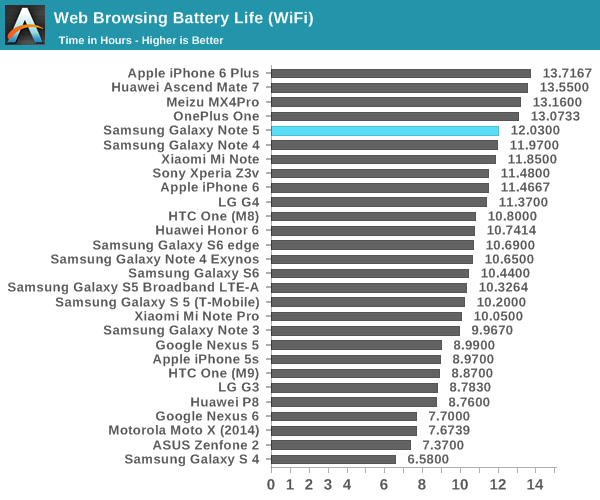
In our first test of WiFi web browsing, the Galaxy Note5 performs identically to the Galaxy Note 4. This might be surprising because the display is the same size and resolution as the Galaxy Note 4 with a smaller battery than the Galaxy Note 4. However, the smaller battery is compensated for due to improvements in SoC and display efficiency. In particular, the move from a planar 28nm process to a 14nm FinFET process dramatically reduces power consumption on the SoC.

In LTE battery life, we see a noticeable drop relative to WiFi battery life. It’s likely that this is mostly due to the power consumption of the Shannon 333 modem present in these devices. There’s not much else to say here, but battery life is still good.
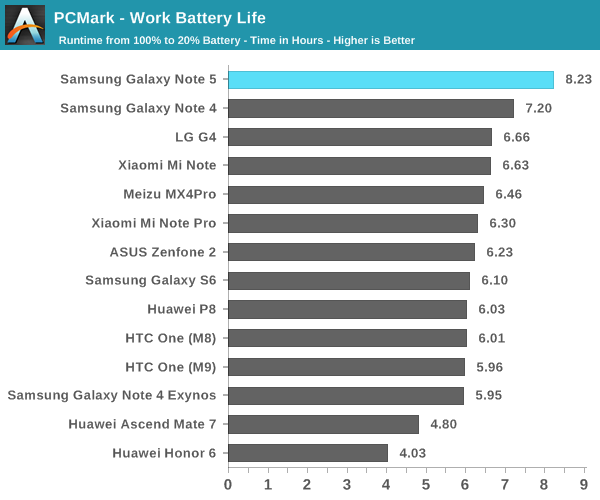
Moving past our mostly display-bound web browsing test, PCMark provides a much more balanced look at battery life as APL tends to vary a bit more with content like videos and photos instead of just webpages, and the CPU component is much more strongly emphasized. Here we can really see the Note5’s Exynos 7420 stretch its legs as it keeps a high performance level with long runtime.
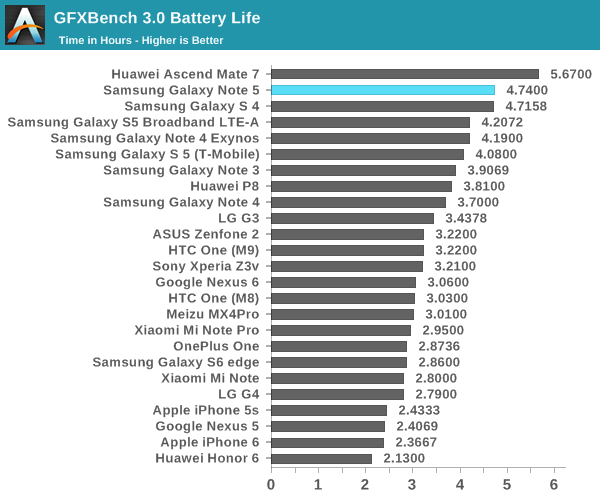
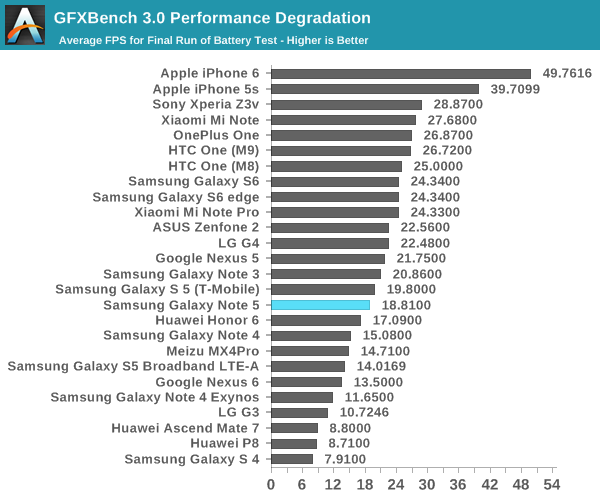
In our sustained SoC-bound workloads, GFXBench shows a healthy improvement over the Galaxy S6. Although we’re unable to test in perfectly controlled temperatures, it looks like Samsung has improved the throttling behavior of the SoC as the throttling appears to be more graceful rather than sinusoidal, and the result is a pretty significant jump in runtime over most devices.
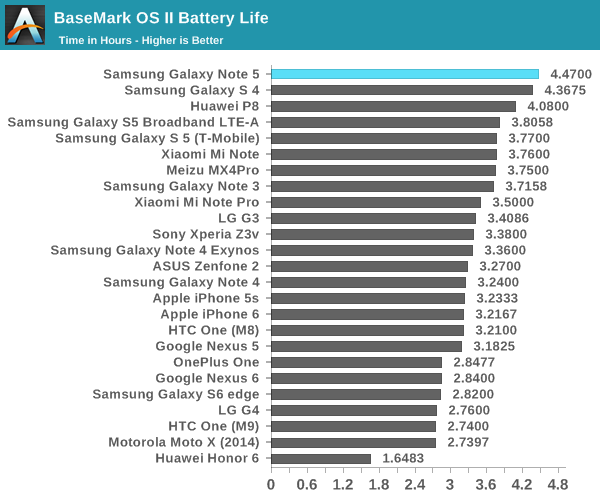

In Basemark OS II, we see a pretty significant uplift in runtime when compared to something like the Galaxy S6 or Note 4. The runtime increase isn’t just due to excessive throttling though, as the battery score shows that this isn’t just a case of throttling the CPU until the runtime is an improvement over past devices.
Overall, if you’ve read the Galaxy S6 review it’s pretty fair to say that you’ll know what to expect from the Galaxy Note5. Battery life is roughly equivalent to the Galaxy Note 4 despite the smaller battery, and due to the greatly improved Exynos 7420 SoC relative to 2014 SoCs SoC-bound cases will show pretty healthy improvements as long as you’re controlling for performance.
Charge Time
While normally battery life is the primary area of concern for a smartphone, in some cases it’s important for a phone to charge quickly. We can all claim to be perfect but one of the simplest cases for faster charging is forgetting to plug the phone in before going to sleep, so the maximum allowable charge time goes from something like 6 hours to an hour at best. As a result, a faster charger can dramatically improve practical battery life in any situation where you have limited time to charge. This can be accomplished by increasing either the current or voltage of the charger. The original quick charging standards improved charge rate through higher current, but this eventually hits a wall due to resistance in the wire. In order to increase the total amount of power delivered without increasing the thickness of the cable used voltage was increased in the case of newer standards like QC 2.0. In the case of the Galaxy Note5 and Galaxy S6 edge+, we’re looking at the same 9V, 1.67A QC 2.0 compatible charger that shipped with the Galaxy Note 4. In order to test this properly, we log the time it takes for the phone to charge by running a timer until the charger power draw hits a point that represents 100% battery.
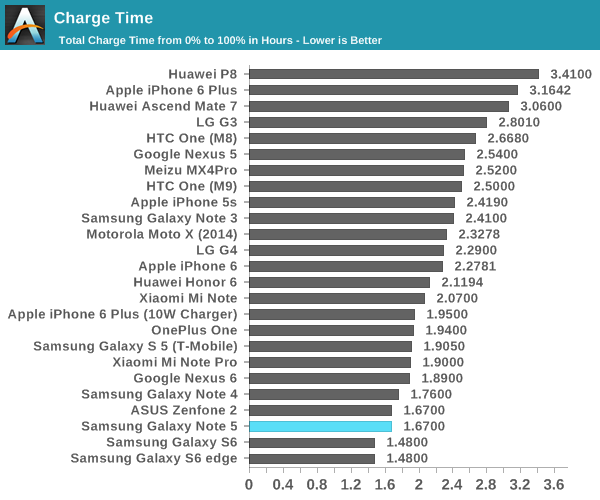
It probably isn’t a surprise, but charge time ends up similar to the Galaxy S6 and Galaxy Note 4. I suspect that we’ll be waiting until QC 3.0 to be able to see significant improvements as the current standard doesn’t have particularly fine-grained voltage scaling according to cable and phone conditions. Interestingly, the wireless fast charger is actually not too far off from the wired charger as it indicates 100% around 1.84 hours into charging which is almost identical to the wired fast charger.


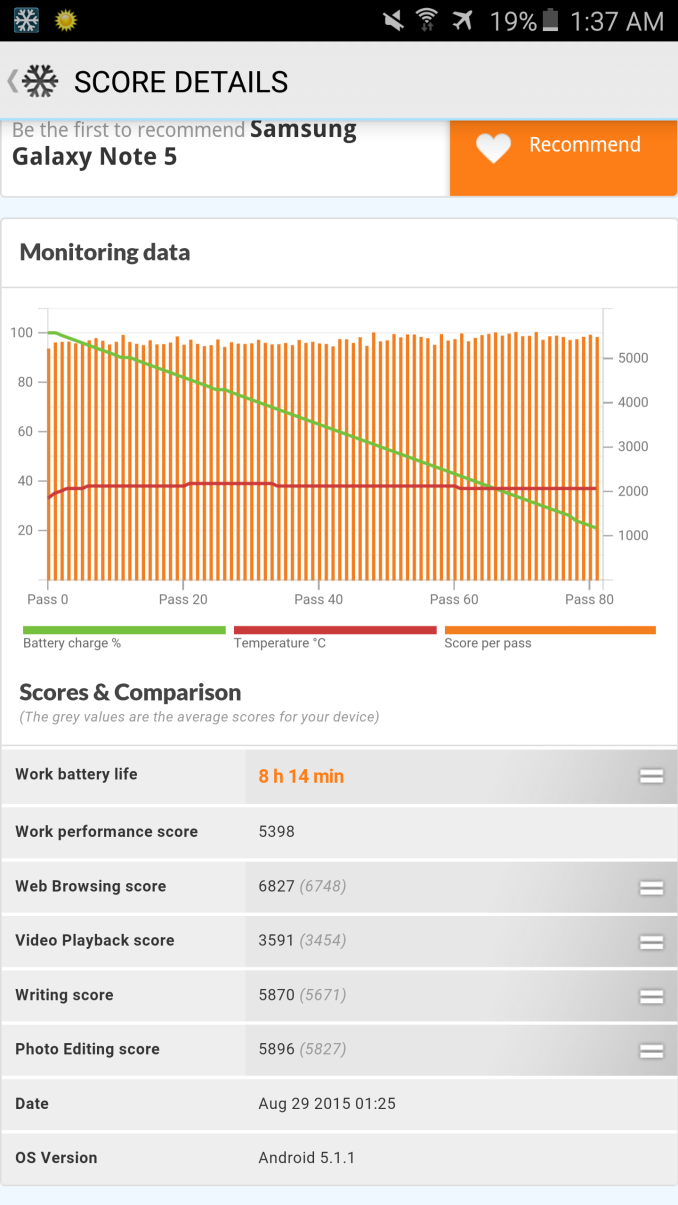
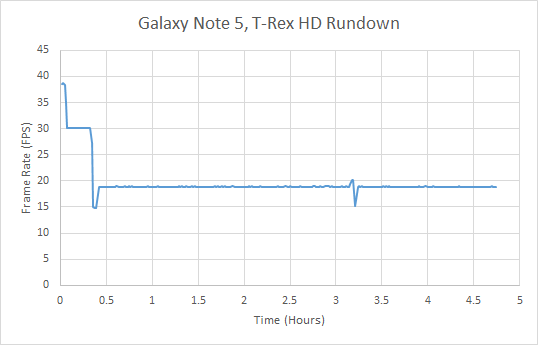
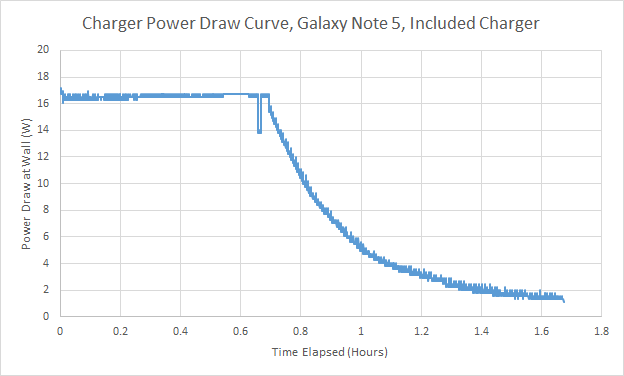
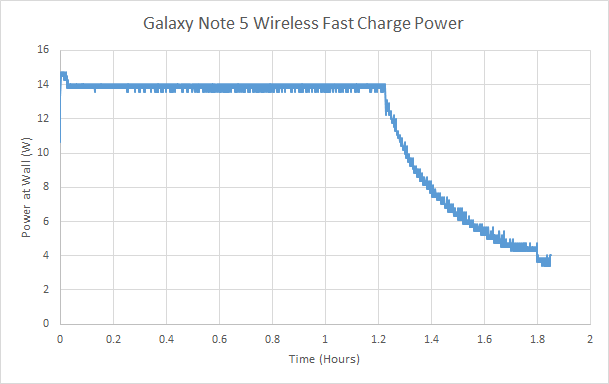








225 Comments
View All Comments
forgot2yield28 - Friday, October 2, 2015 - link
How about a Moto X Pure review? I'm sure I'm not alone in wanting to get your take on how it stacks up against the big Samsung and Apple phones.danbob999 - Friday, October 2, 2015 - link
I would like to see screen-off and idle battery tests. Most of the time my phone sits on the table, receiving emails in the background.Dobson123 - Friday, October 2, 2015 - link
THIS! I got some bad battery numbers with the S6 in idle mode with an active internet connection (WLAN and LTE), don't know what causes this.Shark321 - Friday, October 2, 2015 - link
Agreed. My phone sits around with screen off 90% of the day.WoodyPWX - Friday, October 2, 2015 - link
Great review as always, thank you!plonk420 - Friday, October 2, 2015 - link
just a side note, in your comparisons between phones, why does the Lumia 735 (one i'm pondering) and a few others have a handful of lights reflecting? odd setup on your behalf? or is the CCD actually picking that up?JoshHo - Friday, October 2, 2015 - link
I believe this is some extra lighting Brett uses, not a sensor issue.zimmybz - Friday, October 2, 2015 - link
Dude... I can //feel// your disdain by reading written words. This review was clearly a chore. It's such a "meh" effort.I understand you prefer Apple products, and in this case, I can even readily admit that the 6S Plus is probably going to trounce this phone.
I used to come here because there was very little non-technical (specs don't lie) bias in your reviews. I guess those days are gone now.
Here is the major problem - some of us just don't LIKE iOS. It has nothing to do with whether or not it's a technically superior device year to year or whether it has a this or a that.
Reviews like this are what made me stop clicking a lot of other places. I can appreciate that you like iOS better. But an unbiased review of the product in which I can't hear you saying "whatever, it's not an iPhone" the entire time is not what Anandtech used to be.
zimmybz - Friday, October 2, 2015 - link
That last line should read: But a biased review of the product....Ryan Smith - Friday, October 2, 2015 - link
"I understand you prefer Apple products"While we appreciate the feedback all the same, just to be clear here, Josh is a day-to-day Android user. Which is not to say that he doesn't do a thorough job on both kinds of phones, but I hope you aren't ignoring a good article just because of misconceptions about the author.=)